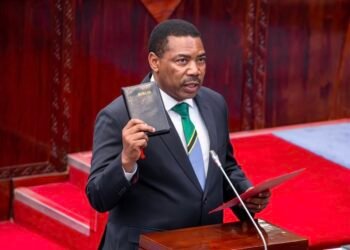KATHMANDU: Nepal’s sudden political convulsion, the resignation of K.P. Sharma Oli, the appointment of former chief justice Sushila Karki as interim prime minister, and the president’s decision to dissolve parliament and set elections for March 5, 2026- has exposed far more than a momentary leadership vacuum. It has laid bare a generational rupture at home and created a new set of geopolitical headaches and opportunities across South Asia.
What began as an outcry over a social-media ban quickly transformed into a sweeping youth-led rebellion that forced state institutions to scramble. The protests widely described as a “Gen Z” movement captured public fury over corruption, cronyism and the sense that old elites run politics for themselves while younger Nepalis are denied economic dignity. The unrest forced elite bargains in Kathmandu: two days of fraught negotiations among the president, the army chief and protest representatives produced Karki’s interim role, a stopgap aimed at calming the streets and steering Nepal to elections.
For India the immediate implications are delicate. New Delhi’s quick public endorsement of the interim arrangement reflects both genuine concern for stability on its Himalayan flank and a desire to remain a central interlocutor in Kathmandu’s transition. Stability in Nepal matters to India’s border management, hydropower cooperation and trans-Himalayan infrastructure planning and New Delhi will be focused on ensuring that Kathmandu’s turbulence does not translate into cross-border insecurity or a diplomatic tilt that undercuts long-standing ties.
Beijing, too, is watching closely. Nepal sits squarely inside China’s neighborhood ambitions an overland partner in Belt and Road projects and an object of steady political engagement. Instability complicates Chinese plans for long-term infrastructure and commercial commitments; Beijing will balance caution about overt intervention with efforts to preserve influence through economic incentives and elite outreach. Recent commentary from the region’s press underscores Beijing’s concern that unrest could imperil BRI timelines and investment calculations.
Outside powers aside, Nepal’s upheaval echoes a pattern of youthful insurgency and regime flux that South Asia has seen in recent years and those precedents offer lessons for both Kathmandu and its neighbors. Sri Lanka’s 2022 mass mobilization over economic collapse and governance failures precipitated a rapid political reversal of the Rajapaksa era and a prolonged period of instability; that uprising showed how economic distress and elite capture can coalesce into street power that upends old bargains. Pakistan’s turbulent political transitions since 2022, and Bangladesh’s recent waves of student and youth protests, likewise demonstrate that mass mobilization can topple governments quickly but does not by itself guarantee coherent policy reforms or institutional renewal. External actors seeking predictable partners are often left negotiating with interim arrangements or technocratic governments that have limited mandates and little political capital to deliver deep reforms.
Economically, Nepal’s crisis illuminates an uncomfortable truth: political instability amplifies the country’s structural vulnerabilities. Heavy dependence on remittances, a narrow industrial base and chronic youth unemployment mean that social unrest is as much about livelihoods as about liberties. The political reset now underway must therefore be judged not only by who governs but by whether the new authorities can deliver economic confidence jobs, private-sector revival, and credible anti-corruption measures so that protest energy is channeled into ballots rather than back onto the streets. In short, a transition that fails to address the economy will be a temporary reprieve, not a solution.
Regionally, Nepal’s turbulence will complicate diplomacy in three ways. First, it will force India and China into a careful triage: both will seek to protect their strategic interests without appearing to meddle overtly a harder balancing act when local popular sentiment is raw and suspicious of outside influence. Second, the rapid arrival of a youth-driven political actor reshapes how New Delhi and Beijing conduct soft power: development projects, scholarships, and youth exchanges may get reframed as instruments to win hearts and minds, not just strategic footholds. Third, the risk of contagion the idea that successful youth mobilization elsewhere might encourage imitative unrest will make capitals across South Asia jittery; governments in Islamabad, Dhaka and Colombo will likely recalibrate both security postures and political messaging to head off their own domestic flare-ups.
For Pakistan, where political volatility and street politics have repeatedly reshaped elite calculations, Nepal’s example is a reminder that protests can rapidly change the matrix of power but rarely erase deeper structural fissures. For Bangladesh, which has seen student and mass movements in recent years, Kathmandu’s experience will be read as both inspiration and warning: mobilization can force change, but it also invites repression if institutions are ill-prepared. Sri Lanka’s economic collapse and political aftershocks remain the cautionary tale: popular uprisings can remove leaders yet still leave societies exposed to economic ruin and geopolitical exploitation if governance reforms do not follow.
What now? Kathmandu must convert this moment of popular energy into an institutional reset that addresses corruption, expands economic opportunity and rebuilds trust in state institutions. Regional powers must respect Nepal’s sovereignty while remaining ready to assist with humanitarian and stabilizing support but they must avoid transactional deals that entrench the same patronage networks that fueled the revolt. International observers and donors should condition help on transparent, results-oriented reforms that create jobs and strengthen rule of law.
Ultimately, Nepal’s crisis is a test for South Asia’s political systems: can aging elites accommodate an assertive, digitally connected generation, or will the region continue cycling through episodic eruptions that yield little long-term reform? The answer will shape not only Nepal’s future but the strategic calculations of its neighbors. One thing is certain a restless generation has made itself the pivotal actor in Kathmandu’s next chapter, and the world must listen!
— WNN Op-Ed | Dr. Shahid Siddiqui, follow via X @shahidsiddiqui
WATCH, EXCLUSIVE TALKS and SUBSCRIBE CHANNEL FOR MORE





















